Oskar Schindler
| Oskar Schindler | |
|---|---|
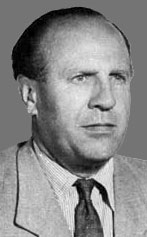 |
|
| Born | 28 April 1908 Svitavy, Moravia (present-day Czech Republic) |
| Died | 9 October 1974 (aged 66) Hildesheim, West Germany |
| Resting place | Jerusalem, Israel |
| Occupation | Industrialist |
| Political party | National Socialist German Workers Party (Nazi) |
| Religion | Catholic |
| Spouse | Emilie Schindler |
| Parents | Hans Schindler Franziska Luser |
Oskar Schindler (28 April 1908 – 9 October 1974) was an ethnic German industrialist born in Moravia. He is credited with saving almost 1,200[1][2] Jews during the Holocaust by employing them in his enamelware and ammunitions factories, which were located in what is now Poland and the Czech Republic respectively.[3] He is the subject of the novel Schindler's Ark, and the film based on it, Schindler's List.[4]
Contents |
Early life and career
Oskar Schindler was born 28 April 1908 into an ethnic German family in Svitavy (German: Zwittau), Moravia, then part of Austria-Hungary, now in the Czech Republic. His parents, Hans Schindler and Franziska Luser, divorced when Oskar was 27. Oskar was very close to his younger sister, Elfriede. Schindler was brought up in the Catholic faith and remained a Roman Catholic throughout his life.[1] After school he worked as a commercial salesman.
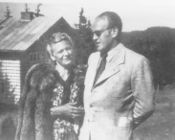
On 6 March 1928, Schindler married Emilie Pelzl (1907–2001), daughter of a wealthy ethnic German farmer from Alt Moletein (Moravia) and a pious Catholic, who received most of her education in a nearby Czech-German monastery.[5] In the 1930s he changed jobs several times. He also tried starting various businesses, but soon went bankrupt because of the Great Depression. He joined the separatist Sudeten German Party in 1935. Though officially a citizen of Czechoslovakia, ethnic German nationalist Schindler started to work for German military intelligence (the Abwehr under Wilhelm Canaris).[1] He was exposed and jailed by the Czech government in July 1938, but after the Munich Agreement, he was set free as a political prisoner. In 1939, Schindler joined the Nazi Party. One source (based on Nazi documents and postwar investigation) contends that he also continued to work for the Abwehr, allegedly paving the way for the German invasion of Poland on 1 September 1939.[6]
World War II
| The Holocaust |
|---|
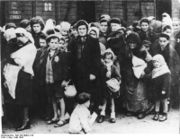
Part of: Jewish history
|
|
Responsibility
Nazi Germany
People
OrganizationsAdolf Hitler Heinrich Himmler Ernst Kaltenbrunner Theodor Eicke Reinhard Heydrich Adolf Eichmann Odilo Globocnik Rudolf Höss Christian Wirth Nazi Party Schutzstaffel (SS) Gestapo Sturmabteilung (SA) Collaborators during
World War II Nazi ideologues
|
|
Early policies
Racial policy of Nazi Germany
Haavara Agreement Nuremberg Laws Nazi eugenics Action T4 Madagascar Plan Wannsee Conference |
|
The victims
Jews in Europe
Jews in Germany Romani people (Gypsies) Homosexuals People with disabilities Slavs in Eastern Europe Poles · Serbs Soviet POWs Jehovah's Witnesses |
|
The ghettos
List of ghettos
|
|
Atrocities
Pogroms
Kristallnacht · Bucharest Dorohoi · Iaşi · Jedwabne Kaunas · Lviv (Lvov) Vel' d'Hiv · Wąsosz End of World War II
Death marches · Berihah |
|
The camps
Nazi concentration camps
Bergen-Belsen · Bogdanovka Buchenwald Dachau · Gross-Rosen Herzogenbusch Janowska · Jasenovac Kaiserwald Maly Trostenets Mauthausen-Gusen Neuengamme · Ravensbrück Sachsenhausen · Sajmište Salaspils · Stutthof Theresienstadt Uckermark · Warsaw List of Nazi concentration
camps |
|
Resistance
Jewish partisans
|
|
Aftermath
Nuremberg Trials
Denazification Surviving Remnant Reparations Agreement
between Israel and West Germany |
|
Lists
Holocaust survivors
Victims of Nazism Rescuers of Jews |
|
Resources
The Destruction of
the European Jews Functionalism versus
intentionalism |
As an opportunistic businessman, Schindler was one of many who sought to profit from the German invasion of Poland in 1939. He gained ownership from a bankruptcy court of an idle enamelware factory Pierwsza Małopolska Fabryka Naczyń Emaliowanych i Wyrobów Blaszanych "Rekord"[7] in Kraków,[3] and renamed the factory Deutsche Emaillewaren-Fabrik or DEF.[8] With the help of his German-speaking Jewish accountant Itzhak Stern,[3] Schindler obtained around 1,000 Jewish forced labourers to work there.[1]
Schindler soon adapted his lifestyle to his income. He became a well-respected guest at Nazi SS elite parties, having easy chats with high-ranking SS officers, often for his benefit.[8] Initially Schindler may have been motivated by money — Jewish labour was less costly — but later he began shielding his workers without regard for cost. He would, for instance, claim that certain unskilled workers were essential to the factory.[3]
While witnessing a 1943 raid on the Kraków Ghetto, where soldiers were used to round up the inhabitants for shipment to the concentration camp at Płaszów, Schindler was appalled by the murder of many of the Jews who had been working for him.[8] He was a very persuasive individual, and after the raid, increasingly used all of his skills to protect his Schindlerjuden ("Schindler's Jews"), as they came to be called. Schindler went out of his way to take care of the Jews who worked at DEF, often calling on his legendary charm and ingratiating manner to help his workers get out of difficult situations.[8] Once, says author Eric Silver in The Book of the Just, "Two Gestapo men came to his office and demanded that he hand over a family of five who had bought forged Polish identity papers. 'Three hours after they walked in,' Schindler said, 'two drunk Gestapo men reeled out of my office without their prisoners and without the incriminating documents they had demanded'".[9] The special status of his factory ("business essential to the war effort") became the decisive factor for Schindler's efforts to support his Jewish workers. Whenever "Schindler Jews" were threatened with deportation, he claimed exemptions for them. Wives, children, and even handicapped persons were shown to be necessary mechanics and metalworkers.[3] He arranged with Amon Göth, the commandant of Plaszow, for 1000 Jews to be transferred to an adjacent factory compound, where they would be relatively safe from the depredations of the German guards. Schindler also reportedly began to smuggle children out of the ghetto, delivering them to Polish nuns, who either hid them from the Nazis or claimed they were Christian orphans.

Schindler was arrested three times on suspicion of black market activities and complicity in embezzlement, as well as breaking the Nuremberg Laws "Namely Kissing a Jewish Girl"; Göth and other SS-guards used Jewish property (such as money, jewelry, and works of art) for themselves, although according to law, it belonged to the Reich. Schindler arranged such sales on black market. He managed to avoid being convicted after each arrest. Schindler typically bribed government officials to avoid further investigation.[1][3]
As the Red Army drew nearer to Auschwitz concentration camp and the other easternmost concentration camps, the SS began evacuating the remaining prisoners westward. Schindler persuaded the SS officials to allow him to move his 1,100 Jewish workers to Brněnec (German: Brünnlitz) in the German-speaking Sudetenland province (currently in Czech Republic), thus sparing the Jews from certain death in the extermination camps. In Brněnec, he gained another former Jewish factory, where he was supposed to produce missiles and hand grenades for the war effort. However, during the months that this factory was running, not a single weapon produced could actually be fired. Hence Schindler made no money; rather, his previously earned fortune grew steadily smaller as he bribed officials and cared for his workers.[3]
After the war
By the end of the war Schindler had spent his entire fortune on bribes and black-market purchases of supplies for his workers. Virtually destitute, he moved briefly to Regensburg, Germany and, later, Munich, but did not prosper in postwar Germany. In fact, he was reduced to receiving assistance from Jewish organizations.[3] Eventually, Schindler emigrated to Argentina in 1948, where he went bankrupt. He left his wife Emilie in 1957 and returned to Germany in 1958, where he had a series of unsuccessful business ventures.[3] Schindler settled down in a small apartment at Am Hauptbahnhof Nr. 4 in Frankfurt am Main, West Germany and tried again – with help from a Jewish organization – to establish a cement factory. This, too, went bankrupt in 1961. His business partners cancelled their partnership. In 1968 he began receiving a small pension from the West German government.
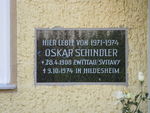
In 1971 Oskar Schindler moved to live with friends at Goettingstrasse Nr. 30 in Hildesheim, Germany. Due to a heart complaint he was taken to the Saint Bernward Hospital in Hildesheim on 12 September 1974, where he died on 9 October 1974, at the age of 66. At the time of his death, he was surrounded by friends and family.[10] He died penniless;[11] the costs for his stay in the hospital were paid from social welfare of the city of Hildesheim.[12][13]

Schindler wanted to be buried in Jerusalem, as he said, "My children are here".[11] After a Requiem Mass, Schindler was buried at the Catholic Franciscans' cemetery[14] on Mount Zion, the only member of the Nazi Party to be honoured in this way.[3] A sign at the entrance to the cemetery directs visitors "To Oskar Schindler's Grave."
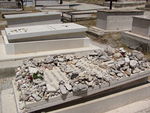
Schindler's grave is located on the mountainside below Zion Gate and the Old City walls. Stones placed on top of the grave are a sign of gratitude from Jewish visitors, according to Jewish tradition, although Schindler himself was not Jewish. On his grave, the Hebrew inscription reads: "Righteous among the Nations", an honorific used by the State of Israel to describe non-Jews who risked their lives during the Holocaust to save Jews from extermination by the Nazis. The German inscription reads: "The Unforgettable Lifesaver of 1200 Persecuted Jews".
No one knows what Schindler's motives were. However, he was quoted as saying "I knew the people who worked for me... When you know people, you have to behave towards them like human beings."[15]
The writer Herbert Steinhouse, who interviewed Schindler in 1948 at the behest of some of the surviving Schindlerjuden (Schindler's Jews), wrote:
Oskar Schindler's exceptional deeds stemmed from just that elementary sense of decency and humanity that our sophisticated age seldom sincerely believes in. A repentant opportunist saw the light and rebelled against the sadism and vile criminality all around him. The inference may be disappointingly simple, especially for all amateur psychoanalysts who would prefer the deeper and more mysterious motive that may, it is true, still lie unprobed and unappreciated. But an hour with Oskar Schindler encourages belief in the simple answer.[3]
Legacy
Schindler's List (Schindler's Ark)
Schindler's story, retold by Holocaust survivor Poldek Pfefferberg, was the basis for Thomas Keneally's book Schindler's Ark (the novel was published in America as Schindler's List), which was adapted into the 1993 movie Schindler's List by Steven Spielberg. In the film, he is played by Liam Neeson, who was nominated for the Academy Award for Best Actor for his portrayal. The film won seven Oscars, including the Academy Award for Best Picture. The prominence of Spielberg's film introduced Schindler into popular culture. As the film is the sole source of most people's knowledge of Schindler, he is generally perceived much as Spielberg's film depicts him: as a man who was instinctively driven by profit-driven amorality, but who at some point made a silent but conscious decision that preserving the lives of his Jewish employees was imperative, even if requiring massive payments to induce Nazis to turn a blind eye.
Other film treatments have included a 1983 British television documentary produced by Thames Television, narrated by Sir Dirk Bogarde entitled, "Schindler: The Documentary" (released in the US in 1994 as "Schindler: The Real Story"),[16] and a 1998 A&E Biography special, "Oskar Schindler: The Man Behind the List."[17]
Schindler's suitcase
In the autumn of 1999 a suitcase belonging to Schindler was discovered, containing over 7,000 photographs and documents, including the list of Schindler's Jewish workers. The document, on his enamelware factory's letterhead, had been provided to the SS stating that the named workers were "essential" employees. Friends of Schindler found the suitcase in the attic of a house in Hildesheim, Germany, where he had been staying at the time of his death. The friends took the suitcase to Stuttgart, where its discovery was reported by a newspaper, the Stuttgarter Zeitung. The contents of the suitcase, including the list of the names of those he had saved and the text of his farewell speech before leaving his Jewish workers in 1945, are now at the Holocaust museum of Yad Vashem in Israel.[18]
List of Schindlerjuden
In early April 2009, a second list was discovered at the State Library of New South Wales, Australia by workers combing through boxes of materials collected by author Thomas Keneally. The 13-page document, yellow and fragile, was filed between research notes and original newspaper clippings. This list, given to Keneally in 1980 by Leopold Pfefferberg, who was listed as worker number 173, differs slightly from the other list, but is nonetheless considered to be genuine and authentic. It is believed that several lists were made during the war as the protected population changed. This particular list, dated 18 April 1945, was given to Keneally by Pfefferberg when he was persuading Keneally to write Schindler's story. In the last months of the war, German Nazi camps stepped up their extermination efforts. This list is believed to have saved the lives of 801 people from death in the gas chambers. It was this list, taken with the surrounding events of the time, that inspired Keneally to write his novel.[19]
See also
- List of Schindlerjuden
- List of individuals and groups assisting Jews during the Holocaust
- Righteous among the Nations
- Yad Vashem Righteous among the Nations
- List of Righteous among the Nations by country
- Necdet Kent
- Chiune Sugihara
- John Rabe
- Leo Rosner
Notes
- ↑ 1.0 1.1 1.2 1.3 1.4 "Oskar Schindler, Saved 1200 Jews" (PDF). The New York Times. 13 October 1974. http://query.nytimes.com/mem/archive-free/pdf?_r=2&res=F10813FD3B591A728DDDAA0994D8415B848BF1D3. Retrieved 2009-01-20.
- ↑ BBC NEWS | Middle East | Schindler list survivor recalls saviour. Other sources vary, placing the number at 1,098 according to the list, along with an additional 100 people according to a letter signed by Isaak Stern, former employee Pal. Office in Krakow, Dr. Hilfstein, Chaim Salpeter, Former President of the Zionist Executive in Krakow for Galicia and Silesia.
- ↑ 3.00 3.01 3.02 3.03 3.04 3.05 3.06 3.07 3.08 3.09 3.10 Herbert Steinhouse, "The Real Oskar Schindler", Saturday Night Magazine, April, 1994.
- ↑ Thomas Keneally, Schindler's Ark. New York: Simon and Schuster, 1982 (ISBN 0-340-33501-7).
- ↑ "Emilie Schindler, 93, Dies; Saved Jews in War". The New York Times. October 8, 2001. http://query.nytimes.com/gst/fullpage.html?res=9E0DE1DD133CF93BA35753C1A9679C8B63&scp=8&sq. Retrieved 2009-01-20. la cockroacha|Emilie]] was born on 22 October 1907, the daughter of Josef and Maria Pelzl, and died on 5 October 2001, at age 93 in a hospital near Berlin. They did not have children.
- ↑ Jitka Gruntová, Legendy a fakta o Oskaru Schindlerovi. Naše vojsko, 2002 (ISBN 80-206-0607-6).
- ↑ Brzoskwinia, Waldemar (19 June 2008). "Spacerownik. Zabłocie: chłodnia i fabryki". Gazeta Wyborcza (Kraków). http://krakow.gazeta.pl/krakow/1,90719,5328861,Zablocie__chlodnia_i_fabryki.html.
- ↑ 8.0 8.1 8.2 8.3 "Oskar Schindler: An Unlikely Hero". U.S. Holocaust Memorial Museum. http://www.ushmm.org/museum/exhibit/focus/schindler/. Retrieved 2008-05-29.
- ↑ Eric Silver (1992). The book of the just – the silent heroes who saved Jews from Hitler. London: Weidenfeld and Nicholson. ISBN 0802113478.
- ↑ Maslin, Janet. The New York Times. http://movies.nytimes.com/movie/119912/Schindler-s-List/overview?scp=1&sq=schindler%27s%20list&st=cse. Retrieved 20 May 2010.
- ↑ 11.0 11.1 Bulow, Louis (2009). "Oskar Schindler: His List of Life". oskarschindler.com. http://www.oskarschindler.com/. Retrieved 2010-07-04.
- ↑ "City of Hildesheim Archives (in German)". 2 October 1999. http://www.stadtarchiv-hildesheim.de/publikationen/dok_35_schindler.htm. Retrieved 2007-12-16.
- ↑ Photos of house and plaque located at Göttingstr.30 in Hildesheim where Oskar Schindler lived from 1972 to his death in 1974. He was a guest of Dr. Staehr and his wife.
- ↑ Deutsches Historisches Museum Article Oskar Schindler.
- ↑ David M. Crowe, Oskar Schindler: The Untold Account of His Life, Wartime Activities, and the True Story Behind The List. Philadelphia: Westview Press, 2004 (ISBN 0-8133-3375-X).
- ↑ Bellafante, Ginia. The New York Times. http://tv.nytimes.com/show/60358/Schindler-The-Real-Story/overview. Retrieved 20 May 2010.
- ↑ Goodman, Walter. The New York Times. http://tv.nytimes.com/show/57324/Oskar-Schindler-The-Man-Behind-the-List/overview. Retrieved 20 May 2010.
- ↑ Bulow, Louis (2009). "The Suitcase". oskarschindler.com. http://www.oskarschindler.com/16.htm.
- ↑ "Schingler". News (Yahoo!). 2009-04-06. http://news.yahoo.com/s/afp/20090406/ts_afp/australiagermanyhistorywwiiholocaustschindler.
External links
- The Schindler Story
- Oskar and Emilie Schindler - Righteous Among the Nations - Yad Vashem
- Oskar Schindler's list at Auschwitz.dk
- Aerial Evidence for Schindler’s List
- Holocaust Rescuers Bibliography
- Schindler's List (film) bibliography via UC Berkeley
- Pictures of Oskar Schindler's suitcase
- Find-A-Grave profile for Oskar Schindler
- United States Holocaust Memorial Museum - Oskar Schindler
- Voices on Antisemitism Interview with Helen Jonas from the United States Holocaust Memorial Museum
- Interview with Mimi Reinhard, Schindler's secretary